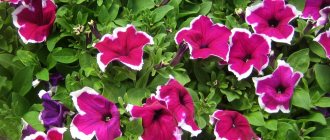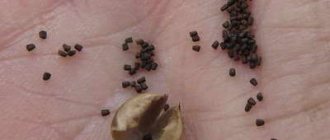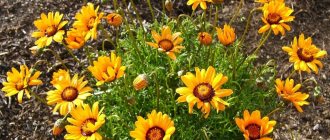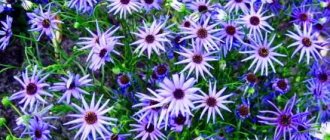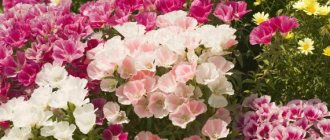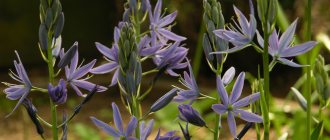Helenium is an annual or perennial plant of the Asteraceae family. This genus includes about 32 species. They can be found naturally in North and Central America, and most of them grow in the Western United States. It is believed that this plant was named helenium in honor of the wife of King Menelaus, the charming Helen, who became the cause of the war that broke out between Troy and Greece. It was described in the Iliad by Homer. What makes such plants stand out? The fact is that until a certain time they have a completely unremarkable appearance. At the end of the summer, when many plants are already blooming, helenium appears in all its glory. Its inflorescences-baskets of golden color, which can change their color, look very elegant and fill the garden with their “calm” beauty...
Features of Helenium
The plant has herbaceous shoots that grow up to 80-170 cm. The upper part of the stems branches. They are decorated with dark green leaves along their entire length. They have an elongated or lanceolate shape and reach 3-7 cm in length.
Even in perennial heleniums, the aboveground part dies off every year along with the root system. They retain only growth buds in the structure of old roots. From these fragments a lush flower grows next year.
Flowering time varies depending on the variety. There are early and late species. Most heleniums bloom from July to September. At this time, they are complemented by beautiful basket-shaped inflorescences framed by corrugated bracts. They can have different shades - red, pink, purple, yellow. In the center there are reed and tubular flowers.
After flowering is completed, fruits appear. They appear as achenes with an airy pappus - pappus.
Helenium in landscape design
Helenium photo of flowers seedlings when to plant Helenium in the garden photo
Helenium is planted in large flower beds in the background, near ornamental shrubs, in groups or singly. They decorate the fence of buildings. Tall helenium goes well with autumn asters.
Helenium hybrid rubinzwerg in landscape design photo
Their inflorescences look great in bouquets and compositions; they are cut when fully bloomed, since water does not affect their bud opening.
Types and varieties of helenium
In total there are more than 30 plant species. But a maximum of 5 are grown on plots. Each crop has certain characteristics.
Bigelow (bigelovii)
It is the least popular crop native to western North America. It is characterized by straight stems reaching a height of 80 cm. The leaves are lanceolate in shape.
The inflorescences reach a diameter of 6 cm. There are tubular flowers in the center. They are brown in color. Reed flowers have a yellow tint. The culture blooms in June and July.
Spring (vernalis)
Helenium is characterized by straight stems reaching 1 m in height. It has lanceolate foliage of a single form. Inflorescences reach 7 cm in diameter. Reed flowers are orange in color, tubular flowers are brown. The bush blooms for 1 month. The first inflorescences appear in mid-May.
Gupes (hoopesii)
The shrub grows up to 90 cm. It is characterized by whole lanceolate leaves with a gray-green color. The culture is decorated with long flower stalks. This type of helenium has single flowers. They are characterized by a yellow tint. The inflorescences reach 8-9 cm in diameter. They appear in June and July.
Autumn (autumnal)
This is the most popular variety, from which many varieties of helenium were bred. This species is characterized by tall bushes, reaching 160 cm. The leaves are small in size and have jagged borders.
The baskets grow up to 3-5 cm and form corymbose inflorescences. Tubular flowers are dark in color, while reed flowers are yellow or red. The bush blooms from July to September.
Hybrid (hybridum)
This is a collective category that includes cultures of unknown origin. But the original species of all representatives of this category is autumnal helenium.
The most popular varieties of hybrid crops include the following:
- Cockade. The height of the crop reaches 120 cm. The baskets have a diameter of 4.5 cm. The reed flowers are red with a brown tint. They are yellowish at the edges, but red pigment predominates in the middle. The tubular flowers are yellow-brown in color. Flowering begins in August and lasts 1.5 months.
- Helenium Rubincverg. This is a popular crop, which is a dense bush reaching 65 cm in height. It is characterized by ruby baskets. This helenium blooms at the end of July.
- Moerheim Beauty. This is one of the most common varieties. When blooming, the flowers acquire different shades - copper, red, yellow. When they fully open, they turn red-brown. Bushes can have different heights - it all depends on the composition of the soil. On average they reach 90-120 cm. The bush begins to bloom in July and ends in November.
Growing from seeds to seedlings
It is allowed to propagate Helenium species by seed. Varietal and hybrid crops do not retain all the properties of the mother plant. Flower seeds are characterized by low germination. Therefore, growing a crop will require time and effort.
Seeds can be planted directly in open soil or grown by seedlings. In the second case, this is done at the end of February or March.
Soil and container
Seeds can be planted in a common container. As the seedlings grow, they will need to be planted. It is also allowed to immediately place 2-3 seeds in separate pots. In this case, the sprouts can be immediately planted in open ground.
For helenium, universal soil for flowering crops is suitable. Sand and peat will help make it looser and more nutritious. To plant seeds, fill the container with substrate and place the seeds, keeping an interval of 2-3 cm.
You should not plant bushes too densely. Otherwise, the seedlings will stretch out very much. Then the container must be covered with film and placed in a warm place.
Seedling care
The seeds of the crop germinate at +18-20 degrees. The first shoots appear after a few weeks. It is recommended to place them in a well-lit place. If daylight hours are too short, additional lighting is required.
Crops need to be watered systematically. However, it is important to avoid stagnation of moisture. After the sprouts appear, it is recommended to remove the cover. When 2-3 leaves appear, the seedlings can be planted in separate containers.
Transplanting
When the weather is warm and the risk of frost has passed, the flowers can be transplanted into open ground. Usually it is recommended to do this in the second half of May. In the southern regions, the procedure is allowed to be carried out earlier.
It is recommended to begin hardening off the plants a few weeks before planting. To do this, they are gradually accustomed to fresh air. This procedure will facilitate the process of adaptation of the crop after planting in open ground.
Before planting, it is recommended to dig up the area, remove weeds, and add compost if necessary. You also need to make landing recesses. The seedlings should be carefully removed. If it was grown in peat containers, flowers can be planted with them.
The roots must be immersed in a container of water. This will help saturate them with moisture. After which you can move the plants into the prepared recesses. Sprinkle with soil and cover with a mulching layer of peat or humus. The interval between plants should be 30 cm.
Reproduction and planting
Often gardeners try to propagate flowers on their own. It is not difficult.
Helenium reproduces in 3 ways:
- dividing the bush;
- cuttings;
- seeds.
Dividing the bush
The best way to propagate helenium is to divide the bush. The procedure is usually carried out in the spring (March-April), once every 2-3 years. Dividing the bush is very beneficial for the health of helenium. In the spring, a plant with a lump of earth is dug up, the youngest, outer parts are separated, used for planting, the middle is thrown away. Young plants will be more viable and will provide more new flowers.
Propagation by cuttings
A more complex way to obtain young plants is by planting cuttings. Cuttings are prepared in the spring in April-May, cutting off the upper part of the shoot. The shoots are germinated and rooted in a moist sandy-peat substrate. The seedlings take root within a week.
Propagation by seeds
Helenium produces a large number of seeds. It should be borne in mind that varieties propagated from seed usually do not retain the characteristics of the mother plant.
Plant seeds in pots or containers from February to June. 1 g contains 2400-5000 seeds (depending on the variety); to obtain 1000 plants, 0.5 g of seeds should be sown. It is preferable to sow seeds in trays. After sowing, cover the seeds well with a small amount of vermiculite to ensure sufficient moisture.
The substrate temperature during the germination period should be 18-22 ° C. Germination lasts 2-3 weeks. After the formation of the first true leaves, the temperature should be gradually lowered to 12-15 ° C, and the humidity around the plants should be reduced.
How and when to plant helenium?
Seedlings should not be prepared and planted in the fall, because young plants will not survive winter, especially if the weather at this time of year is constantly changing (alternating rain and frost). Heleniums transplanted in autumn may rot in winter.
Seedlings should be planted in open ground in the spring, at the end of May. Planting pattern: at a distance of 50 × 50 cm. When growing, a uniform planting is obtained.
For planting helenium, it is recommended to use a peat substrate with a low clay content (15-30%) and a loosening material, such as sand (0-20%), with a soil pH of 5.6-6.4.
Planting helenium can be done in the following ways:
- separately in pots with a diameter of 11-12 cm;
- 2-3 jokes in pots with a diameter of 15 cm.
When planting, it is preferable to strengthen the substrate with a slow-acting multicomponent fertilizer at a dose of 1.5-3.0 kg/m³.
Care after landing
It is recommended to feed young seedlings after the appearance of true leaves and after planting in pots with multicomponent fertilizers. If the soil is too wet and the temperature is low, the plants may die.
Sowing seeds in open ground
You can plant helenium seeds directly in open soil. This will help save the time and effort required to obtain seedlings.
Landing dates
Planting work can be carried out in early spring or late autumn. In the first case, plants should be planted after the threat of frost has passed. Usually this procedure is carried out at the end of April or in May.
If the climate allows, you can plant plants in March.
Autumn planting is carried out immediately after collecting the seeds. This usually happens in October. It should be cool during this period so that the seeds do not germinate before winter. Otherwise, the death of the sprouts is inevitable.
Choice of location and lighting
Helenium requires full illumination. Varieties with yellow inflorescences can withstand light partial shade, while crops with red flowers need full light.
That’s why it’s so important to choose the right place for planting.
It is recommended to grow helenium in an area with fertile soil. It must have neutral acidity and sufficient moisture. It is worth adding sand and humus to heavy and clayey soil.
Landing rules
In the prepared area, you need to make shallow trenches, maintaining a distance of 30-35 cm. Seeds should be planted quite rarely. This will help avoid thinning the plantings. Then the crops should be covered with soil and watered. When the plants reach 8-10 cm, they are planted. Between the bushes you need to make a distance of about 30 cm.
Care
For lush flowering, it is necessary to follow the rules of flower care: monitor watering, fertilize, loosen the soil, spray against pests and diseases, and pruning.
Watering
In temperate climates, helenium is watered every week. One plant consumes 2-3 liters of water. Water that has been settled in advance or collected from a spring is used. In arid climates, watering is increased to 2 times a week, and in frequent rains it is kept to 1 time every 2 weeks.
Loosening and weeding
Loosening is carried out after each watering and rain. The top layer of soil is loosened with a hoe, and all weeds are removed. Weeds deteriorate the quality of the soil and absorb some of the minerals, depleting the soil. If you do not do regular weeding, this will affect the quality of flowering. Loosening and weeding enrich the roots of the plant with oxygen.
Top dressing
Helenium is fertilized 3 times per season, the first at the beginning of the season, after planting or the appearance of the first shoots, the second during flowering, and the third after collecting seeds and preparing for wintering.
In May
In May, mineral fertilizers with a high nitrogen content are applied. Nitrogen improves flowering and accelerates the growth and development of the plant.
Important! Excessive application of nitrogen to the soil negatively affects the development of the plant.
During flowering
During flowering, helenium needs feeding, as the plant spends a lot of energy on the formation of buds and flowers. Use mineral complexes containing phosphorus, potassium, and copper.
You can use wood ash.
At the end of October
At the end of October, seeds form on the shoots. After collecting seeds and pruning, complex mineral fertilizers containing nitrogen, phosphorus, and potassium are applied. They are applied in dry form, during the winter the minerals are absorbed into the soil, and by spring they are absorbed by the plant.
Spraying
To prevent the development of diseases and attacks by pests, preventive treatment of bushes with insecticides and fungicides is carried out. Solutions are sprayed in dry, windless weather. Treatment is carried out at the beginning of the growing season, before flowering begins.
Topping
At the beginning of flowering, pinch out the side shoots; this procedure produces abundant flowering. The plant, instead of expending energy on the formation of shoots, will switch to the formation of flowers.
Transfer
Helenium depletes the soil, so it needs to be replanted every 3-4 years. To do this, choose a suitable new place and fertilize it. Transplantation is carried out in the spring, before flowering begins. At this time, you can propagate the bushes by division.
Diseases and pests
Helenium has strong immunity; the flower is resistant to fungal diseases and insect attacks. However, if the growing and planting conditions are not met, the flower is attacked by the chrysanthemum nematode. These are small worms that penetrate the roots of the plant and the buds. Affects all parts of the plant. To combat them, they are treated with a chemical insecticide and the roots are watered with hot water. All affected areas of the flower are cut off and burned.
Pruning inflorescences
Helenium produces inflorescences gradually. Some have already faded, while others are in bud state. It is recommended to cut off wilted and fading flowers, this speeds up the formation of new flowers.
Outdoor care
In order for helenium to fully develop, it needs to be provided with high-quality and complete care. It includes timely watering, weeding, and fertilizing.
Watering
These are quite moisture-loving plants. They need regular watering. The soil should be moistened several times a week. In hot weather, this procedure should be performed every day. It is important that water is well absorbed into the soil. It is worth avoiding stagnation near plants.
To supply the root system of flowers with a sufficient amount of oxygen, it is recommended to periodically loosen the soil. It is important to break the crust on the soil surface.
Feeding and fertilizer
To achieve normal development and full flowering of the crop, you need to add nutrients in a timely manner. Helenium should be fed 3 times during the season. The first time this is done immediately after planting. To do this, you can use potassium sulfate or mullein infusion. A urea solution is also suitable.
When the crop begins to bloom, mixtures based on phosphorus and potassium can be used. An effective drug is Agricola-7. You can also use mullein infusion. The third time feeding is carried out at the end of October. To do this, you can use ash or superphosphate.
Trimming
To form a lush and beautiful bush, systematic pruning is required. As the culture develops, shoots need to be pinched. This will help stimulate the plant to branch. Withered flowers are removed. This helps to restart flowering.
It is worth considering that large plants can be damaged by rain or gusts of wind. That's why they need to be tied up.
Every 3-4 years, large bushes are recommended to be divided into fragments. In autumn, it is recommended to cut dry branches and leaves to the ground. The root system should be insulated with sawdust, fallen leaves or moss. The thickness of such a layer should be at least 10 cm.
Growing conditions and proper care
How to plant helenium in open ground photo
Beautiful heleniums prefer well-lit areas; they do not tolerate shading. To plant them, you need to select fertile soils that have a sufficient amount of moisture and a neutral acidity level.
When planting lush heleniums in the garden, you should take into account the characteristics of growth in the natural environment: plants prefer fertile meadow soils with a sufficient level of moisture, where forbs grow.
- Densely planted flower beds are an excellent habitat for heleniums.
- Low-growing varieties can be planted at the front of a mixborder or as borders; tall varieties look great in the background.
- Lush bushes look great as tapeworms against the backdrop of a neat lawn.
- Heleniums like regular watering because they do not tolerate drought.
It is necessary to pay special attention to growing heleniums during the dry summer heat. They respond well to feeding with natural organic matter.
Similar procedures must be carried out three times during the entire active growing season.
After 4 years of growing helenium in one place, it is worth seriously thinking about replanting, because the plants quickly age and degenerate. It is advisable to do this procedure in the autumn. If at the end of the summer season a flowering helenium was purchased, then before planting it, cut off the upper part of the stem so that a height of 12 cm remains; we plant it carefully, without affecting the root system.
Experienced gardeners know that helenium bushes may not withstand the harsh winter of the Moscow region. To provide the plant with a better chance of survival, it is better to cover the bush with fallen leaves, spruce branches or artificial covering material for the winter, and in winter be sure to ensure that there is snow on top, especially during severe frosts.
The outer flowering stems of helenium live only for a season, dying back for the winter, like all perennials. But, unlike everyone else, at the end of the warm season, even the root collar of Heleniums dies off. It is renewed by buds appearing at the base of the stem. In a snowy winter without severe frosts, Heleniums overwinter well, but in harsh, snowless winters they can freeze out.
Susceptibility to cold is increased in hybrid varieties of Helenium, which are particularly thermophilic.
When preparing the plant for winter, it is worth mulching the plant thoroughly with moss or sawdust, or you can cover it with ready-made lutrasil. In order for the plant to winter comfortably, you need to trim the tops of adult plants before covering.
Protection from pests and diseases
Helenium is a resistant plant that has strong immunity. If agrotechnical recommendations are strictly followed, there will be no problems when growing crops.
However, sometimes the flower suffers from attacks of chrysanthemum nematodes. They provoke damage to leaves and stems. As a result, these parts of the plant become dark and die.
To cope with nematodes, sulfur or slaked lime should be added to the soil. However, it is best to dig up and destroy the affected plants. After the procedure, it is recommended to treat the area where the infected flower grew with insecticidal preparations.
If there is an excess amount of moisture, there is a risk of rot. Regulating the irrigation regime and systematically loosening the soil will help to avoid this. If helenium is affected by rot, it is recommended to treat it with fungicides.
Reproduction
There are such methods of breeding helenium:
- Seed method. It is recommended to plant seeds in early spring or late autumn directly into the ground. It is also allowed to grow the flower in seedlings. In such a situation, the survival rate of the plant will be higher.
- Cuttings. This is the simplest and fastest method of obtaining a culture. To do this, you need to cut a cutting from the mother plant and immediately place it in the soil. To make the planting material take root better, it can be soaked in a solution of mineral fertilizers.
- Sockets. In this case, the adult plant is divided. To perform the procedure, you need to use a sharp knife to separate a fragment of the above-ground part with roots. Division should be done in the spring. If the procedure is carried out in the fall, the separated parts will begin to grow, which will cause their death.
Autumn care
In autumn, helenium requires feeding. To do this, you need to use superphosphate and potassium sulfate. In order for the bush to continue to bloom, it is necessary to remove fading inflorescences and upper fragments of shoots in a timely manner. If necessary, you can collect seeds. It is recommended to do this before the rains start.
Wintering
To prepare the plant for winter, it is recommended to prune it. This is done almost to the very surface of the soil. There should be no more than 10-15 cm of stem left. After this, it is recommended to sprinkle the bed with mulch - moss, sawdust. Then the plant should be covered with lutrasil. This will help prevent the crop from freezing.
In spring, when there is no threat of frost, this layer must be removed.
Care and reproduction
This plant can be propagated by sowing seeds. They are sown either in late spring or late autumn.
Before sowing, the seeds must be stratified for several months, because autumn helenium is characterized by very poor germination.
Thus, they need to be moistened generously with water, wrapped in plastic wrap and placed in the refrigerator for a month, placed on the vegetable shelf.
A month later, the seeds are placed under a light bulb in a room with an air temperature of about 22 C, where they germinate within a couple of weeks. Then the seedlings are planted, and in May they are planted in an open, well-lit place.
The plant is also propagated by rosettes and green cuttings, but these methods are not as common as propagation by seeds.
Autumn helenium grows very well in fertile, carefully prepared and abundantly moist soil. In addition, it is necessary to ensure that the soil does not dry out. Helenium, which is grown from cuttings and seeds, begins to bloom a year after planting.
After the plant is planted in a permanent place, the young stems should be well mulched with either humus or peat and covered with lutrasil. In addition, it is necessary to regularly provide organic and mineral fertilizer to the soil layer.
To extend the flowering time, it is recommended to promptly remove all faded inflorescences, while capturing a small piece of the stem. As a result, the remaining part will branch, forming young shoots, which will also begin to bloom later.
Plants that are too tall need to be tied up to prevent the stem from breaking due to strong winds. In late autumn, each faded stem is cut back to the ground.
Helenium autumnalis is a winter-hardy plant, but can die after 3-4 winters without regular reproduction.
After flowering
In order for helenium to fully develop, it needs to be provided with high-quality care and proper preparation for winter.
Collecting seeds
After flowering is complete, you can collect helenium seeds. This must be done before the rains start. Otherwise, there is a risk of rotting of the planting material. To assess the ripeness of seeds, you should pay attention to the flowers. Tubular ones become black, and reed ones become darker.
Wintering
In order for the plant to survive the winter well, it needs to be pruned well. The height of the branches after the procedure should not exceed 10-15 cm. The soil should be covered with a layer of mulch, and then Lutrasil should be placed on the surface of the ground, which will protect helenium from frost.



